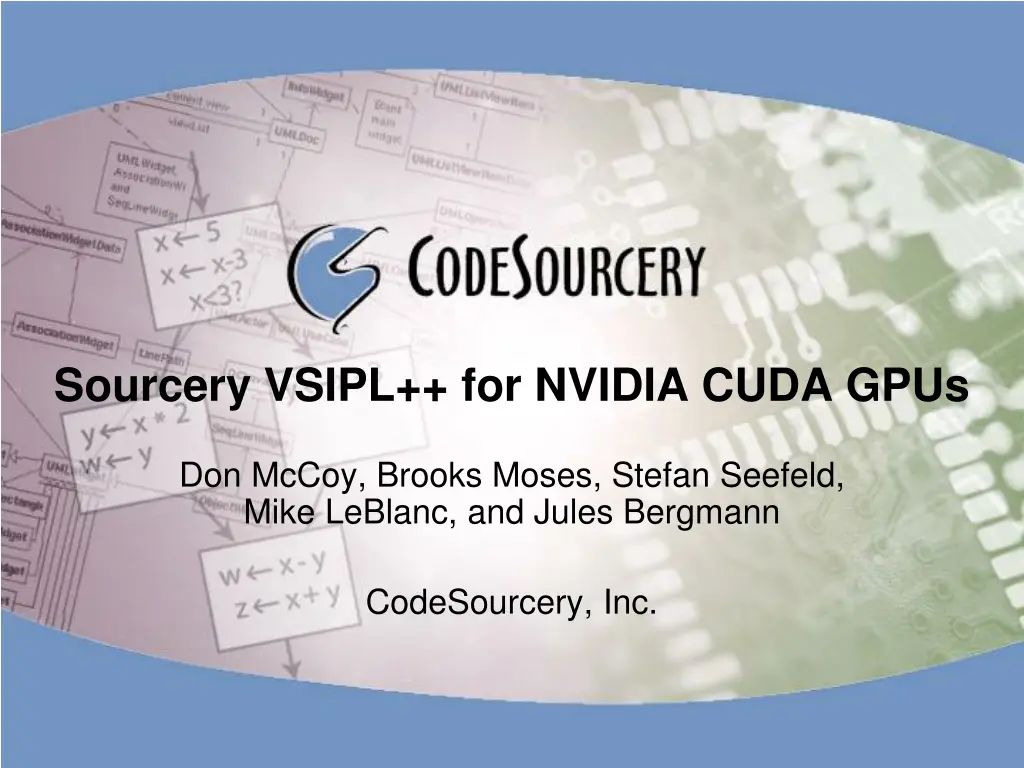
Enhancing Programming Performance with Sourcery VSIPL++ for NVIDIA CUDA GPUs
Explore how Sourcery VSIPL++ optimizes programming performance for NVIDIA CUDA GPUs through portability and competitive results. The library facilitates porting applications like synthetic-aperture radar (SSAR) with ease, maintaining high performance levels.
Download Presentation

Please find below an Image/Link to download the presentation.
The content on the website is provided AS IS for your information and personal use only. It may not be sold, licensed, or shared on other websites without obtaining consent from the author. If you encounter any issues during the download, it is possible that the publisher has removed the file from their server.
You are allowed to download the files provided on this website for personal or commercial use, subject to the condition that they are used lawfully. All files are the property of their respective owners.
The content on the website is provided AS IS for your information and personal use only. It may not be sold, licensed, or shared on other websites without obtaining consent from the author.
E N D
Presentation Transcript
Sourcery VSIPL++ for NVIDIA CUDA GPUs Don McCoy, Brooks Moses, Stefan Seefeld, Mike LeBlanc, and Jules Bergmann CodeSourcery, Inc.
Outline Framing question: How can we preserve our programming investment and maintain competitive performance, in a world with ever-changing hardware? Topics Example synthetic-aperture radar (SSAR) application Sourcery VSIPL++ library for CUDA GPUs Porting the SSAR application to this new target Portability and performance results 23-Sep-09 2
Review of 2008 HPEC Presentation Example code: SSCA3 SSAR benchmark Provides a small but realistic example of HPEC code Sourcery VSIPL++ implementation Initial target-independent version Optimized for x86 (minimal changes) Optimized for Cell/B.E. (a bit more work) Results Productivity (lines of code, difficulty of optimization) Performance (comparison to ref. implementation) 23-Sep-09 3
SSCA3 SSAR Benchmark Formed SAR Image Raw SAR Return Digital Spotlighting Interpolation Range Loop Fast-time Filter Bandwidth Expand Matched Filter 2D FFT-1 Major Computations: FFT mmul mmul FFT pad FFT-1 FFT mmul interpolate 2D FFT-1 magnitude Scalable Synthetic SAR Benchmark Created by MIT/LL Realistic Kernels Scalable Focus on image formation kernel Matlab & C ref impl avail Challenges Non-power of two data sizes (1072 point FFT radix 67!) Polar -> Rectangular interpolation 5 corner-turns Usual kernels (FFTs, vmul) Highly Representative Application 23-Sep-09 4
Characteristics of VSIPL++ SSAR Implementation Most portions use standard VSIPL++ functions Fast Fourier transform (FFT) Vector-matrix multiplication (vmmul) Range-loop interpolation implemented in user code Simple by-element implementation (portable) User-kernel implementation (Cell/B.E.) Concise, high-level program 203 lines of code in portable VSIPL++ 201 additional lines in Cell/B.E. user kernel. 23-Sep-09 5
Conclusions from 2008 HPEC presentation Productivity Optimized VSIPL++ easier than unoptimized C Baseline version runs well on x86 and Cell/B.E. User kernel greatly improves Cell/B.E. performance with minimal effort. Performance Orders of magnitude faster than reference C code Cell/B.E. 5.7x faster than Xeon x86 23-Sep-09 6
Conclusions from 2008 HPEC presentation Productivity Optimized VSIPL++ easier than unoptimized C Baseline version runs well on x86 and Cell/B.E. User kernel greatly improves Cell/B.E. performance with minimal effort. Technology refresh? What about the future? Performance Orders of magnitude faster than reference C code Cell/B.E. 5.7x faster than Xeon x86 What if we need to run this on something like a GPU? Portability to future platforms? 23-Sep-09 7
What about the future, then? Porting the SSAR application to a GPU Build a prototype Sourcery VSIPL++ for CUDA. Port the existing SSAR application to use it. How hard is that port to do? How much code can we reuse? What performance do we get? 23-Sep-09 8
Characteristics of GPUs Tesla C1060 GPU: 240 multithreaded coprocessor cores Cores execute in (partial) lock-step 4GB device memory Slow device-to-RAM data transfers Program in CUDA, OpenCL Cell/B.E.: 8 coprocessor cores Cores are completely independent Limited local storage Fast transfers from RAM to local storage Program in C, C++ Very different concepts; low-level code is not portable 23-Sep-09 9
Prototype Sourcery VSIPL++ for CUDA Part 1: Selected functions computed on GPU: Standard VSIPL++ functions: 1-D and 2-D FFT (from CUDAFFT library) FFTM (from CUDAFFT library) Vector dot product (from CUDABLAS library) Vector-matrix elementwise multiplication Complex magnitude Copy, Transpose, FreqSwap Fused operations: Fast convolution FFTM and vector-matrix multiplication 23-Sep-09 10
Prototype Sourcery VSIPL++ for CUDA Part 2: Data transfers to/from GPU device memory Support infrastructure Transfer of data between GPU and RAM Integration of CUDA kernels into library Integration with standard VSIPL++ blocks Data still stored in system RAM Transfers to GPU device memory as needed for computations, and then back to system RAM Completely transparent to user Everything so far requires no user code changes 23-Sep-09 11
Initial CUDA Results Initial CUDA results Time Digital Spotlight Fast-time filter BW expansion Matched filter Interpolation Range loop 2D IFFT Data Movement Overall Baseline x86 Time Function Performance Speedup 0.078 s 0.171 s 0.144 s 3.7 GF/s 5.4 GF/s 4.8 GF/s 0.37 s 0.47 s 0.35 s 4.8 2.8 2.4 1.099 s 0.142 s 0.215 s 1.848 s 0.8 GF/s 6.0 GF/s 1.8 GB/s 1.09 s 0.38 s 0.45 s 3.11 s - 2.7 2.1 1.8 Almost a 2x speedup but we can do better! 23-Sep-09 12
Digital Spotlighting Improvements Code here is almost all high-level VSIPL++ functions Problem: Computations on GPU, data stored in RAM Each function requires a data round-trip Solution: New VSIPL++ Block type: Gpu_block Moves data between RAM and GPU as needed Stores data where it was last touched Requires a simple code change to declarations: typedef Vector<float, Gpu_block> real_vector_type; 23-Sep-09 13
Gpu_block CUDA Results Initial CUDA results Time Digital Spotlight Fast-time filter BW expansion Matched filter Baseline x86 Time Function Performance Speedup 0.078 s 0.171 s 0.144 s 3.7 GF/s 5.4 GF/s 4.8 GF/s 0.37 s 0.47 s 0.35 s 4.8 2.8 2.4 Gpu_block CUDA results Digital Spotlight Fast-time filter 0.023 s BW expansion 0.059 s Matched filter 0.033 s Baseline x86 12.8 GF/s 15.7 GF/s 21.4 GF/s 0.37 s 0.47 s 0.35 s 16.3 8.0 10.8 Maintaining data on GPU provides 3x-4x additional speedup 23-Sep-09 14
Interpolation Improvements Range Loop takes most of the computation time Does not reduce to high-level VSIPL++ calls As with Cell/B.E., we write a custom user kernel to accelerate this on the coprocessor. Sourcery VSIPL++ handles data movement, and provides access to data in GPU device memory. Much simpler than using CUDA directly User kernel only needs to supply computation code ~150 source lines 23-Sep-09 15
Optimized CUDA Results Optimized CUDA Time Digital Spotlight Fast-time filter BW expansion Matched filter Interpolation Range loop 2D IFFT Data Movement Overall Baseline x86 Time Function Performance Speedup 0.023 s 0.059 s 0.033 s 12.8 GF/s 15.7 GF/s 21.4 GF/s 0.37 s 0.47 s 0.35 s 16.3 8.0 10.8 0.262 s 0.036 s 0.095 s 0.509 s 3.2 GF/s 23.6 GF/s 4.0 GB/s 1.09 s 0.38 s 0.45 s 3.11 s 4.1 10.5 4.7 6.1 Result with everything on the GPU: a 6x speedup. 23-Sep-09 16
Conclusions Sourcery VSIPL++ for CUDA GPUs Prototype code exists now Contains everything needed for SSAR application Porting code to new targets with Sourcery VSIPL++ works with realistic code in practice. GPUs are very different from Cell/B.E., but: 50% performance with zero code changes Much better performance with minimal changes And can easily hook in rewritten key kernels for best performance. 23-Sep-09 17















